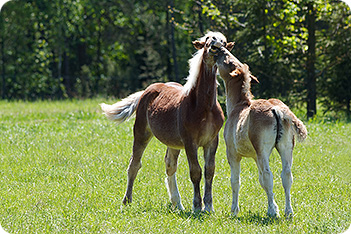
Horse Behaviour
From: Horse 'Equus'
See Also: Horse Behaviour Characteristics • Horse Breeds • Horse Evolution • Horse Gaits

Horse Behaviour
Being able to recognise your horses behaviour is very important not only for their health and general well being but also for your own safety. Horses use a combination of body language signs and also their voice to whinny and use noise through their nostrils to communicate and display their feelings. Understanding this behaviour will help you to recognise if your horse is happy, angry, dozy, asleep, in pain, or frightened.
Behaviour Signs
- Ears
- Ears Forward
This is an alert and attentive sign, often showing happiness. - Ears To The Side
This can show that the horse is relaxed. If the horse is being ridden and their ears are to the side then it shows that the horse is concentrating and relaxed. If the horse is stood still with its neck mid to low in height and with eyes half closed, resting a hind foot with the ears to the side then it shows that the horse is just tired, relaxed and resting. - One Ear Back
This is a sign that the horse is listening. - Ears Mobile
Horse is alert and can hear something of interest, the ears will move around often accompanied by a high neck carriage, bright eyes. - Ears Flat Back
This is a sign of anger and is often accompanied with swishing tail and kicking out by either one or both hind legs.
- Ears Forward
- Eyes
- Eyes Open And Bright
Is a sign of an alert horse who is taking in their surroundings. - Eyes Half Shut
Is a sign that the horse is tired or dozing. Extra signs of this would be ears to the side with head mid to low and resting a hind leg and with a droopy bottom lip. - Eyes Shut
Is a sign hat your horse is asleep. - One Eye Shut
This usually indicates that the horse has a medical issue with the closed eye, so look to see if the eye is weeping or has any discharge and seek veterinary advice.
- Eyes Open And Bright
- Teeth
- Horse Bite
If the horse has bitten either you or another horse and it has been accompanied with the horse having its ears flat back, a back leg kicking out at you and/or a swishing tail, then it is a sign of aggression. - Horses Biting
Horses also bite each other and you if they are grooming each other for pleasure and social interaction, if this is the case then the horse will have their ears either forward or to the side with a relaxed tail and happy expression.
- Horse Bite
Behaviour Signs Continued...
- Lips
- Upper Lip Curl
When horses curl up their upper lip it is known as the 'flehmen technique', and horses do this when they are aware of a scent in the air; for example a stallion will do this when he is aware of a mares hormone scent when she is in season.
- Upper Lip Curl
- Chin
- Droopy
The horses chin and lower lip will often go droopy when they are very sleepy, content or relaxed. Other signs include resting a hind leg, ears to the side and head carriage mid to low in height.
- Droopy
- Nostrils
- Snorting
Horses will make a snorting noise with their nostrils when they are unsure or frightened of something.
- Snorting
- Head And Neck Carriage
- Head High
Head High is often a healthy sign of an alert and curious horse and is often accompanied with alert ears, bright eyes and an alert focused expression. - Head Low
Head Low can either be a sign of submission, depression or simply tiredness. - Neck Curving Around
Neck turning to the side and looking at their flanks can be a sign of discomfort, this can be either due to a fly on the horses side or a more serious upset such as colic in which case other symptoms will also be visible.
- Head High
- Back
- Back Raised
Raised and tight is a sign of discomfort, for example due to a saddle or sore in that area.
- Back Raised
- Tail
- Tail Raised High
Tail raised high in the air is usually accompanied with a high neck carriage, a bright happy and alert expression. Horses are often seen with high tails when playing in the field. - Tail Clamped Down
Tail clamped flat down is a sign of discomfort for example if a fly is under the dock of the horse. o Tail swishing is an aggressive warning sign and can also used as a sign of discomfort. Other accompanying symptoms to look out for are ears flat back and kicking out with one or both back legs.
- Tail Raised High
- Back Legs
- One Leg Kicking
One leg kicking out is an aggressive warning sign. - Both Legs Kicking
Both legs kicking out shows aggression.
- One Leg Kicking
- Forelegs
- Pawing Ground
Pawing the ground can be a sign of impatience, hunger and can also be a symptom of colic which will have other symptoms visible. o - Stamping Ground
Stamping the ground is a sign of impatience and can also be due to discomfort caused by for example a cut or flies on the leg. - Resting Leg
Resting one foreleg is a sign of discomfort in that limb.
- Pawing Ground